Next Task: Bike Side Panels
Ok, so I know almost nothing about making composites and this really is an unconventional way of making a mould, but it works well for simple prototypes like this. It doesn't make really strong, light components, but it makes it good enough for this purpose. These are the steps I followed - they may be wrong - buyer beware!

The frame is a complex shape and to make a panel to fit it exactly is quite difficult, making the mold for the panel would be the hardest part. So instead of making a mold, I used the frame as the mold!
 Step 1:
Step 1: Lie the frame and it's eventaly contents (battery pack) down on a table and put shims under the frame so the battery pack is centered. Put cling film (gladwrap in NZ) over everything.
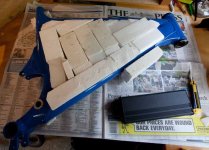 Step 2:
Step 2: Next to make the mould look a nice shape go and mix up a big batch of play-doh!

Yup you read that right, a great cheap, dense maliable thing to make your mould out of.
Step 3: Lay out and mould the playdoh over the frame and battery pack until you have the shape you are looking for. Play-doh is very easy to work with, even kids can do it!

Remember to allow raised areas for things like cable entrance holes, brake cables etc. Once you have the shape you want put another layer of gladwrap over the top and make sure everything is nice smooth. Obviously It isn't a hard mould, in fact it is really soft, so you're not going to be making top quality fiberglass with it (you'll have to put on a few more layers than if you were doing it with a propper mold), but it is easy and painless (and kinda reminicent of ones childhood
 View attachment 4
Step 4:
View attachment 4
Step 4: Next cut pieces of your favourite composite material (fiberglass/carbonfiber - I used 3-4 layers of 200g woven fiberglass cloth) to a bit bigger than the size you need.
By the way, don't be put off trying this fiberglass stuff just because you've never done it before, this was only my third time doing anything with it. I just bought a fiberglass kit from a boat shop for about US$60 and gave it a go. It is really just like adults pape mache!
Step 5: Basically, just mix up some epoxy don a gasmask and rubber gloves and carefully lay up your side cover, one layer at a time making sure that each layer is well wetted with epoxy. I found it easiest to spread the epoxy around just using my hands (with silicon gloves on) It only takes about 30mins. Make sure the windows are open and wear a propper gas mask, this stuff can really make you light headed!
 Step 6:
Step 6:Obviously with this molding technique you can only do one side at a time, but you can even reuse the play-doh. The gladwrap under the fiberglass will inevitably become stuck to the inside, but that doesn't matter because no one sees that bit! I managed to re-use my playdoh after over a week sitting in the mould (with a bit of TLC) and after I was done I put it out with the compost!
 Step 7:
Step 7: Leave to cure for 48 hrs and then trim, sand and admire your handywork.
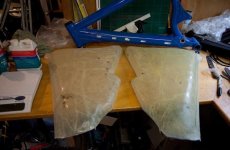
{b}Step 8: [/b] Identify any high/low points (all the pen marks in the previous photo) that you don't like and add bog as appropriate (on the outside or inside depending) It is kind of like icing a cake. (follows on well from all that kneeding with the playdoh!

) After it has cured, sand it till you're happy with it.
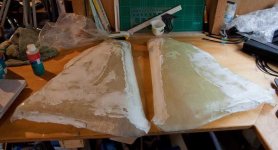 Step 9:
Step 9:(Optional) You may want to heat cure the panels it in a large cardboard box lined with aluminium foil and heated by lightbulbs - a makeshift low temp (100-120deg C) oven for about 12 hours if you want good heat resistance and added stiffness, but for most applications room temp curing should be ok. If you want to heat cure the part, you just need to raise the temp slowly over a period of a couple of hours, eg. start with one bulb on and the box open, then after half an hour close the box, after another half hour turn another bulb on, half an hour later the third bulb goes on and then after another half hour insulate the box with a towel. (A multimeter temp probe is handy) Leave it for 9-12 hours, then reverse the process to cool it down again. (you'll need to do this somewhere where the smell of hot epoxy doesn't bother anyone! Believe me, you don't use the oven in your kitchen!)
Basically with heat curing fiberglass the deal is that it'll start to get softish at about 30deg C higher than the temp at which it was cured at, so if you don't intend having hot batteries or using it in the desert, then room temp curing should be ok, but heat curing seems to make the panels a bit stiffer though, which is a good thing. You'll need to sand the panels again after heat curing because somehow the grain of the fiberglass cloth shows through more afterwards.
Step 10: Paint the panels. Definately only do this after heat treatment (if you choose the heat treatment option) as heat treatment will change the surface of the fiberglass. I found that epoxy spraypaint works pretty well on fiberglass.





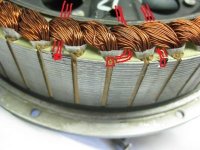
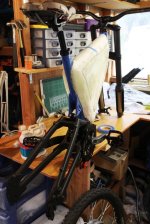 Final width between the knees will be about 118mm
Final width between the knees will be about 118mm 
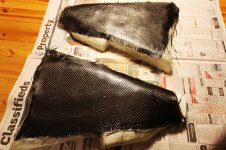
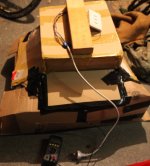
:wink:
